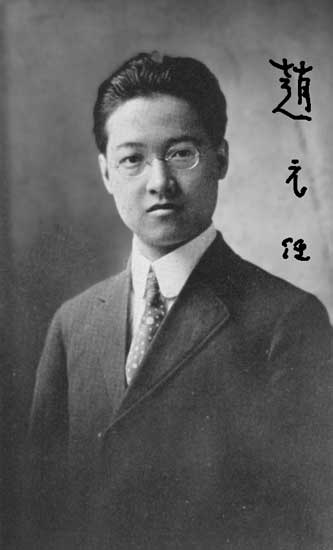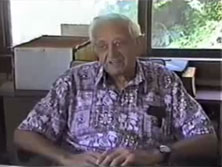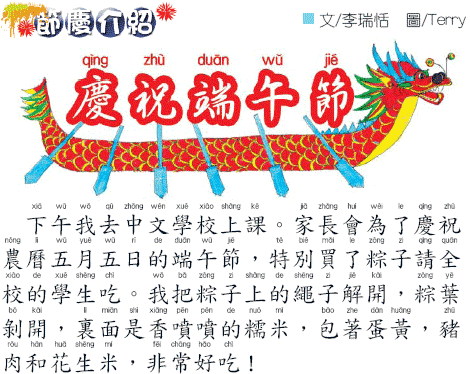A video from the moving memorial service for John DeFrancis is now available online.
It’s almost two hours long, so allot yourself some time if you want to watch it.

A video from the moving memorial service for John DeFrancis is now available online.
It’s almost two hours long, so allot yourself some time if you want to watch it.
 Pinyin.Info has a new reading: Responses to objections to romanization, written by the brilliant linguist Y.R. Chao in 1916, when he was a young man of 24.
Pinyin.Info has a new reading: Responses to objections to romanization, written by the brilliant linguist Y.R. Chao in 1916, when he was a young man of 24.
It’s an unfortunate irony that another writing associated with Chao, the famous “stone lions” (a.k.a. shi, shi, shi) piece, is often mistakenly cited as evidence that the author opposed romanization. In fact, Chao favored using romanization for Mandarin, as his essay reveals.
It’s written in the form of 16 “objections,” each followed by Chao’s reply. For example:
Obj. 8 Alphabetized Chinese loses its etymology.
Rep. 8 This argument is like that often urged against simplified English spelling and is to be met similarly. In actual usage, how much attention do we give to etymology in words like 學, 暴, 發, 旋, 之, through, draught, etiquette, row, disaster? Of how many of these very common words do you know the original meaning? It is not to be denied, of course, that it is useful to know the etymology of words by looking them up, and our future dictionaries of alphabetized polysyllabic words should no doubt give their derivations.
The etymology of disaster (which is pretty cool) is certainly easy enough for an educated person to guess, if you stop to think about it. But I must admit I never had.
I have added notes following the text.
John DeFrancis has died at the age of 97.
I’ll write more about this later. Right now, I’m still too sad.
Sonshi, the largest website dedicated to Sun Zi’s (Sun Tzu’s) Art of War, recently selected Victor H. Mair’s new translation as “the #1 Art of War edition.”
In announcing its judgment, the site stated, “how rare a book that courageously stands up to centuries of established thought, proceeds to knock it down with sound logic and proof, and succeeds in convincing even the Old Guard to change their views.”
Professor Mair has just published a free, book-length companion to his translation: Soldierly Methods: Vade Mecum for an Iconoclastic Translation of Sun Zi bingfa, with a complete transcription and word-for-word glosses of the Manchu translation by H. T. Toh (1 MB PDF).
Yes, all that and Manchu too. The appendixes might well supply the longest text in romanized Manchu available online — not to mention the longest one with English translation. (Perhaps someone from Echoes of Manchu can comment.)
And I’d like to note the introduction to the transcription offers a cool word I hadn’t come across before: Mandjurist, which is German for “Manchu philologist.”
Here’s the table of contents:
This is issue no. 178 of Sino-Platonic Papers.
 Ten years ago John DeFrancis was awarded the Chinese Language Teachers Association’s first lifetime achievement award. Since he could not be present at the association’s annual conference to receive the award, he sent a videotape of a 12-minute acceptance speech. The video was recently edited down to 6:27 and uploaded to YouTube: John DeFrancis remarks.
Ten years ago John DeFrancis was awarded the Chinese Language Teachers Association’s first lifetime achievement award. Since he could not be present at the association’s annual conference to receive the award, he sent a videotape of a 12-minute acceptance speech. The video was recently edited down to 6:27 and uploaded to YouTube: John DeFrancis remarks.
Here’s my summary of the main points:
0:00 — While working on what he intended to be a largely political study of Chinese nationalism, DeFrancis encountered references to people who wanted China to adopt an alphabetic writing system, an idea which he initially dismissed. But discovering Lu Xun’s interest in romanization led him to investigate the matter further. [I’m frustrated by the cut away from this discussion. Perhaps a fuller version of the video will be posted later.]
1:30 — Emphasizes he’s not in favor of completely abandoning Chinese characters. Rather, he favors digraphia.
2:30 — “I’d like to mention three aspects of the Chinese field which have interested me.”
- pedagogy (2:50) — lots of advancements
- linguistic aspect (3:20) — that’s also progressing well
- socio-linguistics (3:52) — the field isn’t doing as well as it should be
5:00 — computers and Chinese characters. DeFrancis tears into the Chinese government for its emphasis on shape-based character-input methods rather than Pinyin.
Sino-Platonic Papers has rereleased for free its sixth volume of reviews, mainly of books about China and its history and languages (5.6 MB PDF).
The reviews are by David Utz, Xinru Liu, Taylor Carman, Bryan Van Nordan, and Victor H. Mair.
Contents
- Review Article by David A. Utz of Ádám Molnár, Weather-Magic in Inner Asia. With an Appendix, “Alttürkische fragmente über den Regenstein,” by P. Zieme. Indiana University Uralic and Altaic Series, 158. Bloomington, Indiana: Indiana University, 1994.
- Graham Parkes, ed., Heidegger and Asian Thought. Honolulu: University of Hawaii Press, 1987. Reviewed by Taylor Carman and Bryan Van Norden.
- Beijing Daxue Nanya Yanjiusuo [Peking University Institute for South Asian Studies], ed. Zhongguo zaiji zhong Nanya shiliao huibian (Collection of South Asian Historical Materials from Chinese Sources). 2 vols. Shanghai: Shanghai Guji Chubanshe, 1995. Reviewed by Xinru Liu.
The following 23 reviews are by the editor of Sino-Platonic Papers.
- Ronald E. Emmerick and Edwin G. Pulleyblank. A Chinese Text in Central Asian Brahmi Script: New Evidence for the Pronunciation of Late Middle Chinese and Khotanese. Serie Orientale Roma, LXIX. Rome: lstituto ltaliano per ii Medio ed Estremo Oriente, 1993.
- YIN Binyong and SU Peicheng, eds. Kexuede pingjia Hanyu hanzi [Scientifically Appraise Sinitic and Sinographs]. Zhongguo yuwen xiandaihua congshu (Chinese Language Modernization Series), 1. Peking: Huayu Jiaoxue Chubanshe (Sinolingua), 1994.
- WU Chang’an. Wenzi de toushi — Hanzi lunheng [A Perspective on Culture — Balanced Discussions on the Sinographs]. Wenhua Yuyanxue Congshu [Cultural Linguistics Series]. N.p. (Changchun?): Jilin Jiaoyu Chubanshe, 1995.
- ZHOU Shilie, comp. Tongxingci cidian [Dictionary of Homographs]. Peking: Zhongguo Guoji Guangbo Chubanshe, 1995. (Reviewed twice from different perspectives in the same issue.)
- KANG Yin. Wenzi Yuanliu Qianshi (The Origin and Development of Chinese Ideographs) (sic). N.p.: Guoji Wenhua Chubanshe, 1992.
- DUAN Kailian. Zhongguo minjian fangyan cidian [A Dictionary of Chinese Folk Topolecticisms]. Haikou: Nanhai chuban gongsi, 1994.
- CHANG Xizhen, comp. Beiping tuhua [Peking Colloquialisms]. Taipei: Shenge Shiye Youxian Gongsi Chubanshe, 1990.
- ZHANG Xunru. Beiping yinxi xiaoche bian [A Compilation of Words with “er” Suffix in Pekingese]. Taipei: Taiwan Kaiming, 1991; 2nd Taiwan ed.; 1956, first Taiwan ed.
- LI Sijing. Hanyu “er” [] yin shi yanjiu [Studies on the History of the “er” [] Sound in Sinitic]. Taipei: Taiwan Shangwu, 1994.
- Erdengtai, Wuyundalai, and Asalatu. Menggu mishi cihui xuanshi [Selected Explanations of Lexical Items in The Secret History of the Mongols]. Mengguzu lishi congshu [Series on the History of the Mongolian People]. Hohhot: Neimenggu Renrnin Chubanshe, 1980; 1991 rpt.
- Matthews, Stephen and Virginia Yip. Cantonese: A Comprehensive Grammar. Routledge Grammars. London and New York: Routledge, 1994.
- Killingley, Siew-Yue. Cantonese. Languages of the World / Materials 06. München-Newcastle: Lincom Europa, 1993.
- ZHONG Jingwen, chief ed. Yuhai (An Encyclopedia of Chinese Folk Language), Vol. 1: Mimiyu (Chinese Secret Language). Vol. editors ZHENG Shuoren and CHEN Qi. Shanghai: Shanghai Wenyi Chubanshe, 1994.
- Harrell, Stevan, ed. Cultural Encounters on China’s Ethnic Frontiers. Seattle and London: University of Washington Press, 1995.
- Woo, Henry K. H. The Making of a New Chinese Mind: Intellectuality and the Future of China. Hong Kong: China Foundation, 1993.
- Miller, Lucien, ed. South of the Clouds: Tales from Yunnan. Translated by GUO Xu, Lucien Miller, and XU Kun. Seattle and London: University of Washington Press, 1994.
- Hoizey, Dominique and Marie-Joseph Hoizey. A History of Chinese Medicine. Tr. by Paul Bailey. Vancouver: UBC Press; Edinburgh: Edinburgh University Press, 1993.
- Crystal, David. An Encyclopedic Dictionary of Language and Languages. London: Penguin, 1992, 1994.
- Day, Gordon M. Western Abenaki Dictionary. Vol. 1: Abenaki-English. Vol. 2: English-Abenaki. Mercury Series, Canadian Ethnology Service, Papers 128 and 129. Hull, Quebec: Canadian Museum of Civilization, 1994-95.
- Hassrick, Peter H. The Frederic Remington Studio. Cody, Wyoming: Buffalo Bill Historical Center, in association with University of Washington Press (Seattle, London), 1994.
- Jonaitis, Aldona, ed. Chiefly Feasts: The Enduring Kwakiutl Potlatch. Seattle and London: University of Washington Press; New York: American Museum of Natural History, 1991.
- Jerry L. Norman and W. South Coblin. “A New Approach to Chinese Historical Linguistics.” Journal of the American Oriental Society, 115.4 (1995),576-584.
Bits and Pieces
- Letter concerning An Zhimin’s views on the origins of bronze metallurgy in China.
- “Yet again on Tibet.” This is one in a continuing series of discussions with Edwin G. Pulleyblank, W. South Coblin, and others on the origins of the name “Tibet”.
This was first published in February 1996 as issue no. 70 of Sino-Platonic Papers.

Victor Mair’s latest post at Language Log introduces a new U.S.-based newspaper, the Huayu Xuebao (Mandarin Learning Newspaper, 華語學報), which is similar to Taiwan’s Guoyu Ribao (Mandarin Daily News), the main difference being the former uses Hanyu Pinyin while the latter uses zhuyin fuhao (bopo mofo).
Well, actually the Huayu Xuebao doesn’t use proper Pinyin (see recent remarks). But I’m so happy to see this long-needed paper that I’ll hold my tongue for now.
Unfortunately, the paper doesn’t have its Web site ready yet — not that the long-established Guoyu Ribao is much better at that, at least when it comes to texts as they appear in the newspaper. So, for more information about the Huayu Xuebao, write learningnewspaper [AT] yahoo.com or phone +1-201-288-9188 (New Jersey).
There’s also a sample issue.
source: How to learn to read Chinese, Language Log, May 25, 2008

Sino-Platonic Papers has rereleased for free its fifth volume of reviews, mainly of books about China and its history and languages (11.6 MB PDF).
Even if you have no particular interest in the specific works reviewed, I recommend at least browsing through this and all of the other volumes of reviews from Sino-Platonic Papers, as they often feature Victor Mair at his most direct and entertaining about a wide range of subjects.
Table of Contents:
- Review Article: The Present State and Future Prospects of Pre-Han Text Studies. A review of Michael Loewe, ed., Early Chinese Texts: A Bibliographical Guide. Reviewed by E. Bruce Brooks, University of Massachusetts at Amherst.
N.B.: The following 29 reviews are by the editor of Sino-Platonic Papers.
- Roger T. Ames, Chan Sin-wai, and Mau-sang Ng, eds. Interpreting Culture through Translation: A Festschrift for D. C. Lau.
- Sau Y. Chan. Improvisation in a Ritual Context: The Music of Cantonese Opera.
- CHANG Xizhen. Beijing Tuhua [Pekingese Colloquial].
- CHANG/AIXINJUELUO Yingsheng [AISINGIORO *Yingsheng]. Beijing Tuhua zhong de Manyu [Manchurian in Pekingese Colloquial].
- BAI Gong and JIN Shan. Jing Wei’er: Toushi Beijingren de Yuyan [“Capital Flavor”: A Perspective on the Language of the Pekingese].
- JIA Caizhu, comp. Beijinghua Erhua Cidian [Dictionary of Retroflex Final-r in Pekingese].
- Julia Ching and R. W .L. Guisso, eds. Sages and Sons: Mythology and Archaeology in Ancient China.
- FENG Zhiwei. Xiandai Hanzi he Jisuanji (Modern Chinese Characters and Electronic Computers).
- FENG Zhiwei. Zhongwen Xinxi Chuli yu Hanyu Yanjiu [Chinese Information Processing and Research on Sinitic].
- Andre Gunder Frank. The Centrality of Central Asia.
- HUANG Jungui. Hanzi yu Hanzi Paijian Fangfa [Sinographs and Methods for Ordering and Looking up Sinographs].
- W. J. F. Jenner. The Tyranny of History: The Roots of China’s Crisis.
- Adam T. Kessler. Empires Beyond the Great Wall: The Heritage of Genghis Khan.
- David R. McCraw. Du Fu’s Laments from the South.
- Michael Nylan, tr. and comm. The Canon of Supreme Mystery, by Yang Hsiung.
- R. P. Peerenboom. Law and Morality in Ancient China: The Silk Manuscripts of Huang-Lao.
- Henry G. Schwarz. An Uyghur-English Dictionary.
- Vitaly Shevoroshkin, ed. Dene-Sino-Caucasian Languages.
- Vitaly Shevoroshkin, ed. Nostratic, Dene-Caucasian, Austric and Amerind.
- Laurence G. Thompson, comp. Studies of Chinese Religion: A Comprehensive and Classified Bibliography of Publications in English, French, and German through 1970.
- Laurence G. Thompson, comp. Chinese Religion in Western Languages: A Comprehensive and Classified Bibliography of Publications in English, French, and German through 1980.
- Laurence G. Thompson, comp. Chinese Religion: Publications in Western Languages, 1981 through 1990.
- Aat Vervoorn. Men of the Cliffs and Caves: The Development of the Chinese Eremitic Tradition to the End of the Han Dynasty.
- WANG Jiting, ZHANG Shaoting, and WANG Suorong, comp. Changjian Wenyan Shumianyu [Frequently Encountered Literary Sinitic Expressions in Written Language].
- John Timothy Wixted. Japanese Scholars of China: A Bibliographical Handbook.
- YÜ Lung-yü, ed. Chung-Yin wen-hsüeh kuan-hsi yüan-liu [The Origin and Development of Sino-Indian Literary Relations].
- ZHANG Guangda and RONG Xinjiang. Yutian Shi Congkao [Collected Inquiries on the History of Khotan].
- ZHANG Yongyan, chief ed. Shishuo Xinxu Cidian [A Dictionary of A New Account of Tales of the World].
- Peter H. Rushton. The Jin Ping Mei and the Non-Linear Dimensions of the Traditional Chinese Novel.
- William H. Baxter, A Handbook of Old Chinese Phonology. Reviewed by Paul Rakita Goldin, Harvard University.
- JI Xianlin (aka Hiän-lin Dschi). Dunhuang Tulufan Tuhuoluoyu Yanjiu Daolun [A Guide to Tocharian Language Materials from Dunhuang and Turfan]. Reviewed by XU Wenkan, Hanyu Da Cidian editorial offices in Shanghai.
- GU Zhengmei. Guishuang Fojiao Zhengzhi Chuantong yu Dasheng Fojiao [The Political Tradition of Kushan Buddhism and Mahayana Buddhism]. Reviewed by XU Wenkan, Hanyu Da Cidian editorial offices in Shanghai.
- W. South Coblin, University of Iowa. A Note on the Modern Readings of 土蕃.
- Rejoinder by the Editor.
- Announcement concerning the inauguration of a new series in Sino-Platonic Papers entitled “Bits and Pieces.”
This work also continues the discussion regarding the Chinese characters “土蕃” and Tibet.
This was first published in July 1994 as issue no. 46 of Sino-Platonic Papers.